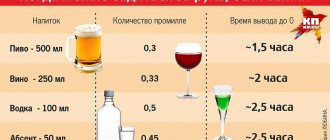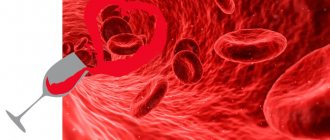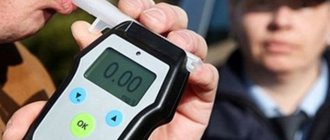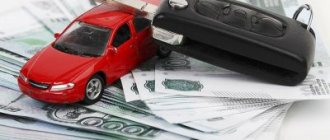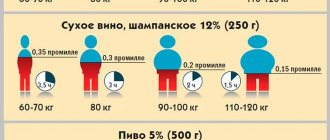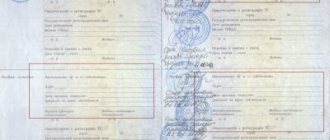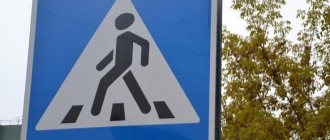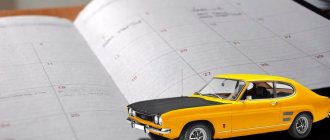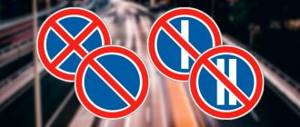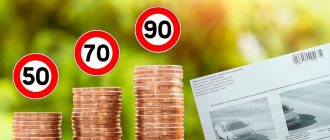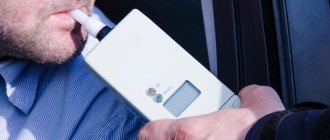How is intoxication determined?
If alcohol is detected in the body above 0.3 ppm, then this indicates that the person is intoxicated. 0.3 ppm is 50 g of vodka, 200 g of wine and 500 g of beer for an average man weighing 80 kg.
If, when tested with a breathalyzer, it was revealed that there is 0.35 ppm of alcohol in a person’s blood, then he is considered drunk. The air exhaled by the driver must contain at least 0.16% ethanol - in this situation the person is considered to be intoxicated.
The issue of the permissibility of drinking non-alcoholic beer while driving is still controversial. Some believe that this drink is harmless, others believe that you should not drink it before a trip. As for police officers and narcologists, the opinion of these specialists is clear: the consequences of excessive consumption of non-alcoholic beer can be catastrophic.
Factors influencing the degree of intoxication
Despite the fact that non-alcoholic beer does not give a positive result on a breathalyzer, there are a number of factors that can increase the effect of the drink on the body:
- Resistance to beer, even non-alcoholic beer, is imparted by body weight: the larger the person, the larger the dose you need to drink to achieve a slight state of intoxication.
- It is much easier for minors to get drunk - the body has not yet developed the habit of coping with alcohol intoxication.
- Alcohol experience—at what age did a person start drinking alcohol?
- The quantity and quality of the snack is taken into account, as well as the amount of food eaten before drinking the drink (even zero drinks on an empty stomach can give a much higher blood alcohol content).
- Self-hypnosis. Scientists have found that alcohol, which is involved in physiological processes, is already present in human blood in minute quantities. When thinking about alcohol, especially for those who are partial to it, under the influence of self-hypnosis, the percentage of alcohol in the blood may increase.
- Some products may contain a small amount of alcohol, and if ingested, a breathalyzer can give positive results: overripe fruits, kefir and other fermented milk products, juices (they are often made with alcohol concentrates), some alcohol medications (valocordin, valerian, motherwort tincture and others ).
Still, it's better to refuse
Is it possible to drink non-alcoholic beer while driving?
To understand whether you can drive after drinking non-alcoholic beer, you need to study the composition of the drinks. Both standard and non-alcoholic beer are produced using the same algorithm. The same raw materials are used for production - it is thanks to this that the beer retains its specific taste. However, “non-alcoholic” beer still contains ethanol.
Don't trust labels. Even if the can has the word “non-alcoholic” on it, it’s just an advertisement . Non-alcoholic beer also contains ethanol, although in smaller quantities.
How to play it safe if you've been drinking
To avoid problems with the traffic police, you do not need to immediately get behind the wheel after drinking non-alcoholic beer. It is advisable to wait half an hour. During this time, the smell will disappear and the device will not detect the presence of alcohol. There are other ways of reinsurance:
You should not try to remove the smell with chewing gum, seeds or special sprays. Such substances do not completely suppress it and, most likely, will arouse unnecessary interest from the inspector who stopped the car. If suspicion arises, he will immediately require you to take an alcohol test using a special device.
Under no circumstances should you refuse to take this test. A driver who refuses to be tested is declared drunk by default. The inspector will accurately draw up a report on the administrative offense and fine the person behind the wheel.
Perhaps the surest way to insure yourself against problems with the police after drinking is to refuse to drive a car. If, of course, circumstances allow such a possibility.
Non-alcoholic beer: how soon can you start driving?
If a person drinks 0.5 liters of non-alcoholic beer, then the ethanol level in his body does not exceed the permissible values. The breathalyzer will most likely show zero results, and after 10-15 minutes the smell of alcohol usually disappears .
If the amount you drank was 2 liters, then it is recommended not to drive for at least 2 hours. Finally, if you drank 3 liters, you should not drive. This can lead to problems when meeting with traffic police officers, and to the risk of an emergency on the road.
At the same time, the driver will have a slight smell of fumes even if he drank very little non-alcoholic drink. As a result, this can lead to problems when meeting with traffic police officers.
Can you get drunk from non-alcoholic beer?
It is this question that leads to reflection: “Is it possible for a driver to drink non-alcoholic beer while driving?” After all, it turned out that in terms of technological characteristics, “nulevka” is almost no different from alcoholic beer. It has a similar taste, a similar color, and a similar hop smell. The drink is consumed according to the same principles, with a traditional snack. Therefore, these factors influence the degree of intoxication. In other words, banal self-hypnosis occurs.
It is difficult to predict how the effect will affect a particular driver. For example, a man sat with friends, drank a couple of cans of Nulevka, then drove home in his car. It seemed like what was criminal about this. The driver did not drink alcohol. The blush just appeared, the pupils slightly dilated, and the rhythm of the heartbeat accelerated.
But you need to be prepared, if the traffic police inspector stops you, the situation will be ambiguous. Well, what is the problem? The facts of alcohol consumption will become visible on the face, and even a small percentage of alcohol in the blood will be shown by a breathalyzer. Then it will be pointless to prove that a simple “zero” was drunk.
How much will 2 cans of non-alcoholic beer show on a breathalyzer?
Experiments by narcologists
One large drug treatment institution conducted an experiment, studying the effects on the body of non-alcoholic beer Clausthaler and Baltika, kvass, kumiss, and natural apple juice. It turned out that even products that are safe and harmless at first glance can cause more problems than non-alcoholic beer, which is still controversial.
The following conditions were met during the study:
- the subjects did not eat anything during the experiment;
- men who differed in weight, physical parameters and immunity were selected as subjects;
- the study was official, the findings were examined by medical specialists.
Before the test, each man was tested for the presence of alcohol in his blood. None of the people tested positive for ethanol . After the test, the specialists used the same breathalyzer. The results were as follows.
| What did you drink? | What quantity | What the breathalyzer showed (in ppm) | |
| Immediately after taking | After 10-15 minutes | ||
| Apple juice | 500 ml | 0,0 | negative indicators indicating the sobriety of the subjects |
| Kumis | 1,04 | ||
| Kvass | 700 ml | 0,0 | |
| "Baltika" | 1 l | 0,09 | |
| Clausthaler | 0,1 | ||
After 15 minutes, specialists interviewed the men, checking their reaction speed and well-being. It was found that the subjects were sober, there was no alcohol in their body, which was determined earlier.
However, immediately after consuming certain drinks, a breathalyzer detected traces of alcohol. The highest levels of alcohol were found in kumys, but the degree of intoxication was mild .
Experts detected a smell of fumes, a rapid pulse, and slightly noticeable disturbances in speech. The subjects' gait became slightly unsteady.
Thus, even if you drank non-alcoholic beer, it is recommended to wait 10-15 minutes rather than get behind the wheel right away. If you are stopped by traffic police representatives a couple of minutes after the start of your trip, this risks leading to problems.
What can a blood test show?
To carry out such an analysis, the amount of blood required for the study is taken from a person’s vein. Typically one of two methods is used:
- Gas chromatography, when 3-5 ml of blood is loaded into a special chamber called a chromatograph. Alcohol is evaporated from the blood plasma, and its content is determined by the amount of ethanol vapor, displayed on the monitor screen of the device. This method is quite accurate, and it is what is used in practice with drivers.
- Enzyme analysis involves the detection of alcohol dehydrogenase, an enzyme that is secreted by the liver after drinking alcohol. If a person drinks, the content of this enzyme increases sharply.
Both methods do not take much time, so a person’s condition can be determined fairly quickly. The results are determined by the following ppm indicators:
- sober state - 0–0.3;
- mild intoxication - 0.3–0.9;
- average intoxication - 0.9–1.9;
- severe intoxication - 2.0–3.3;
- state of torpor - 3.6–3.9;
- The lethal dose is 4.0–5.0.
More on the topic: State Duma deputies proposed introducing bail for drunk driving
Blood test readings are considered the most accurate, and positive results of such an analysis can become the basis for the application of liability measures to the driver, including deprivation of rights.
ATTENTION! In order for the devices to determine the state of the minimum stage of intoxication in a person after drinking non-alcoholic beer, he needs to drink at least 3 liters of the drink within about an hour.
What happens if the traffic police stops you?
The following points must be taken into account.
Breathalyzers function in different ways. The following situation is quite : a person drank a little non-alcoholic beer, waited about an hour, went on the road, and when meeting with representatives of the traffic police, the breathalyzer revealed the presence of alcohol to a somewhat inflated degree.
A lot depends on the driver’s body. Some people do not feel the least bit intoxicated, but for others the consequences are more serious. It is not recommended to take risks: even the slightest decrease in concentration can lead to an accident.
If a traffic police representative smells even a faint odor of alcohol, he will conduct a breathalyzer test. But if the device shows a zero result, then the traffic police representative can still refer the driver for a medical examination, which will demonstrate traces of alcohol in the blood. As a result, the driver will lose time, receive a fine, and be faced with the need to pick up his own car from the impound lot.
In addition, a person runs the risk of losing his driver's license. So, drinking non-alcoholic beer while driving is not recommended - the consequences may be too negative.
Will a breathalyzer show the non-alcoholic beer you have drunk?
The technology for producing a soft drink is similar to the production of regular beer. The difference is that in the first case, the ethanol is evaporated, reducing the alcohol concentration. Thus, non-alcoholic beer still contains alcohol, approximately 0.5% . Therefore, the drink is considered only conditionally non-alcoholic.
You can look at the question from a different angle. Alcohol content is also found in regular drinks:
- Kumis: 0.5–2.5%;
- Kefir: 0.02–00.7%;
- Kvass: 0.7–2.5%.
The drinks are actually considered soft drinks, but if consumed in large quantities, the breathalyzer will also show ppm. After all, even a small amount of alcohol is subsequently absorbed into the blood.
It is worth noting that 2-3 cans of conditionally non-alcoholic beer quickly disappear, but the smell remains. For example, if a driver drank a bottle of non-alcoholic beer and was stopped by an inspector, the breathalyzer will not show intoxication. However, if a traffic police officer smells the smell, the driver will have to go for a medical examination.
How many ppm will a can of non-alcoholic beer show? The indicator depends on the brand and production technology of the drink. After one drink of “zero”, the device monitor will show 0.05–0.22 ppm.
How many ppm are there in alcohol?
Ways to protect yourself
If you have consumed a soft drink, then the following methods will help you hide the “traces of crimes.” First of all, brush your teeth well for at least 5 minutes, use a mouth rinse, a special irrigator for fresh breath.
There are also other means to eliminate the slight smell of alcohol. They act for 15-60 minutes, but in the case of non-alcoholic beer this may be quite enough .
- Take half a lemon, squeeze the juice out of it and add 2-3 drops of vinegar. The resulting solution is used to rinse the mouth.
- Chew nutmeg or roasted coffee beans for a couple of minutes.
- Chew tea leaves, hold them under your tongue or behind your cheek.
- Nibble on the roasted seeds - they also do a good job of eliminating the slight smell of alcohol.
There are special anti-police lollipops. According to manufacturers, they are able to muffle the smell of alcohol, but their duration of action is short. But the affordable cost of lollipops leads to the fact that many drivers use this product when consuming small amounts of alcohol.
Mint chewing gum should not be used - this may enhance the smell of alcohol and arouse suspicion among traffic police officials.
Recommendations for drivers
If those behind the wheel can’t wait to refresh themselves with a soft beer drink, you need to follow a few rules to keep yourself as safe as possible on the road:
- The driver should not apply pressure to the zero level directly while the car is moving. If possible, you need to stop and drink beer. A hearty snack will help not only quickly get rid of the consequences of taking even non-alcoholic products, but also from the smell.
- After taking even a small dose of beer, it is better to clear your head without driving for about 20 minutes.
- During the summer, even beer without degrees can quickly lead to dehydration, so the driver must drink plenty of extra fluids. Under the influence of heat, sunstroke or heatstroke may occur, so it is important for those who are driving to know about this in order to prevent an accident;
- Even non-alcoholic beer has a characteristic odor that is not so easy to get rid of. When checked by a traffic inspector, the aroma emanating from the driver will definitely be noticed. Even if the breathalyzer shows 0 ppm, the smell will serve as a signal for drinking the drink. Therefore, you can beat off the amber with roasted seeds, several chewed coffee beans, and chewing gum (not mint gum).
However, despite all the pros and cons of non-alcoholic beer, the driver of the vehicle needs to remember safety and refrain from drinking this drink while driving. No momentary pleasure is worth getting into a car accident.
Interesting Facts
Not only non-alcoholic beer can make a person a little “intoxicated”. Other seemingly harmless products also have this ability - for example, fermented milk drinks, sweets with the addition of rum or cognac, kvass. Even bananas can begin the fermentation process - especially those that are overripe and have small black spots on the peel.
Ethanol is also found in cigarettes, especially if they are flavored. Toothpastes, mouth rinses and a number of medications also contain ethanol .
A survey of drivers was conducted: people were asked whether they had to drive after drinking alcohol. Almost half of them answered negatively, because, in their opinion, it is deadly. 2.7% of respondents occasionally drive while slightly drunk. 14.8% of respondents drove a car while heavily intoxicated.
And one day a lover of non-alcoholic beer decided to prove to the public that this drink does not cause the slightest harm to the condition, so it is allowed to be safely consumed by those who drive. The man bought 10 liters of beer and drank it. An hour later, his health sharply worsened from such a volume that suddenly entered the body. However, ethanol had no effect on his condition. After this, the man tested with a breathalyzer, which showed a result of 0.02 ppm. These are insignificant indicators, indicating that the subject is almost completely sober. Despite this, such research was not taken seriously.
According to manufacturers, non-alcoholic beer, if you don’t get drunk with it, is even good for human health. it is highly not recommended for pregnant women to consume it - even such a drink can harm the condition of the child and mother. By the way, you should not drink non-alcoholic beer if you want to get rid of alcohol addiction: even the smell is enough for a former alcoholic to break down and go on a binge again.
Drinking non-alcoholic beer while driving can lead to different consequences, since there are many manufacturers of this drink, and they all have their own beer production technologies.
Possible consequences when stopped by a traffic police officer
If a driver gets behind the wheel of a car after using zero and is stopped by a traffic police inspector, the following difficulties and unpleasant consequences may arise:
- Since the effect of different devices differs, it must be taken into account that a breathalyzer may or may not show the alcohol content in the driver’s blood.
- If the inspector insists that the driver is driving while intoxicated, the vehicle will be confiscated and moved to the impound area.
- If a traffic police officer threatens a driver with confiscation of his license if the breathalyzer shows an alcohol content of less than 0.16%, then his actions are subject to appeal. Currently, current legislation does not provide for the confiscation of a driver’s license for a minimum amount of alcohol in the blood.
The driver of the vehicle must remember that if he gets behind the wheel, then it is advisable to forget about drinking alcoholic beverages, even if they are supposedly non-alcoholic. In addition, drinking beer has a number of negative aspects:
- People who have problems with the liver or pancreas should refrain from drinking this drink;
- It is contraindicated to drink beer for pregnant women and nursing mothers, despite the fact that we are talking about a non-alcoholic drink;
- If a person has stomach problems, a pre-ulcer condition or an ulcer, drinking beer is strictly prohibited;
- If you have kidney failure, it is also not recommended to drink beer;
- This soft drink is prohibited if a person is prohibited from drinking alcohol.
Of course, if we draw parallels between zero beer and stronger drinks, the conclusion will be obvious - the consequences of drinking non-alcoholic beer are much simpler. However, this does not mean that the driver should drink alcohol while driving.
In addition, any beer contains hops, which leads to relaxation of the human nervous system, which helps reduce the driver’s reaction to external stimuli. Therefore, it is not recommended to drink even non-alcoholic beer while driving. If the driver’s plans include drinking alcohol, then it is better to abandon plans to drive a vehicle for that day.
If there is an urgent need for a trip, but non-alcoholic beer has been drunk, then after 30-60 minutes the driver can safely get behind the wheel of his car.
How do breathalyzers react to non-alcoholic beer products?
During the meeting with the traffic police inspector, I underwent a special medical examination using a breathalyzer device. Roughly speaking, I breathed into the device and was slightly surprised when the device’s readings exceeded the permissible limits.
After talking with a traffic service employee, I found out that, it turns out, even the most harmless drinks can give out such characteristics, and not just Baltika “nulevka”.
The fact is that when testing the device and determining the current standards for motorists, it was found that even kumiss, apple juice and ordinary kvass give a reaction to alcohol. This is due to the fact that the composition of the drinks is very similar and each of them is prone to fermentation.
As it turned out, except for apple juice and kvass (if you drink up to 1 liter of the composition), each of the listed drinks gives ppm in the blood, namely:
- Baltika “0” - 0.09%;
- kumiss: 1.05% (especially surprising).
If you read the instructions attached to the tester, you can conclude that the person being tested is in a state of mild intoxication, which is characterized by:
- 0.2-1.2 ppm – mild;
- 1.2-2.2 ppm – average;
- 4.7 ppm is a lethal dosage.
In other words, even if you drank non-alcoholic beer or treated yourself to such an exotic drink as kumiss, you should under no circumstances get behind the wheel, since any medical check will show the presence of intoxication.
From this we can draw a small conclusion regarding the question of whether it is possible to drink non-alcoholic beer while driving. If you don’t want to pay a fine, then don’t, since the actions of the state inspector will be completely legal.
